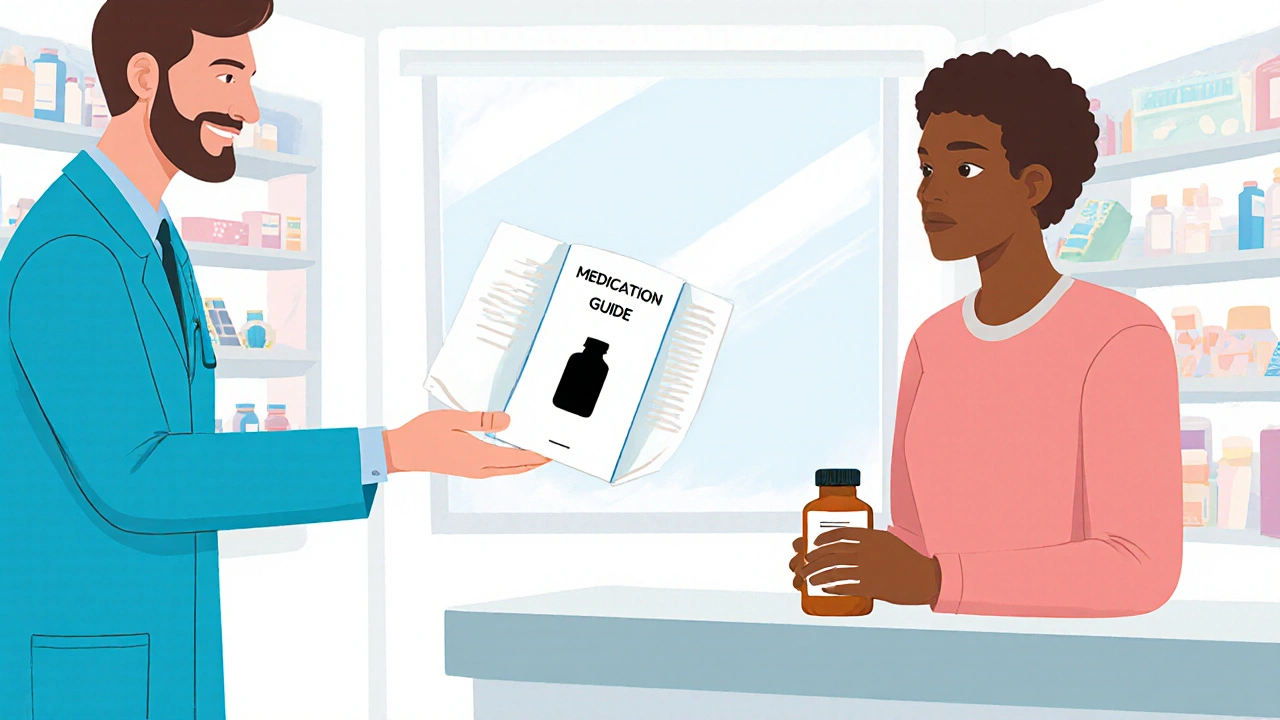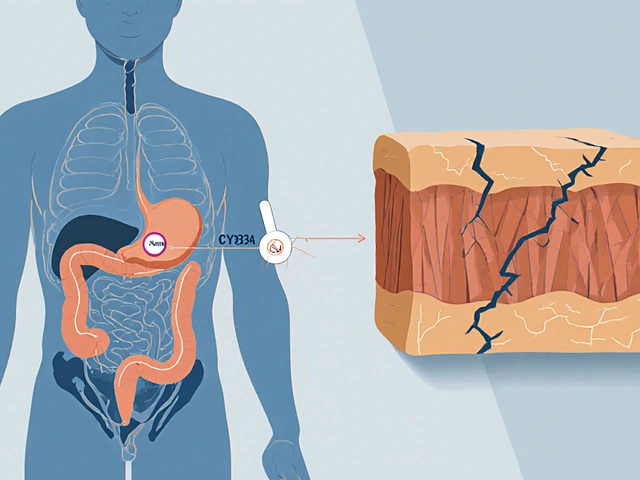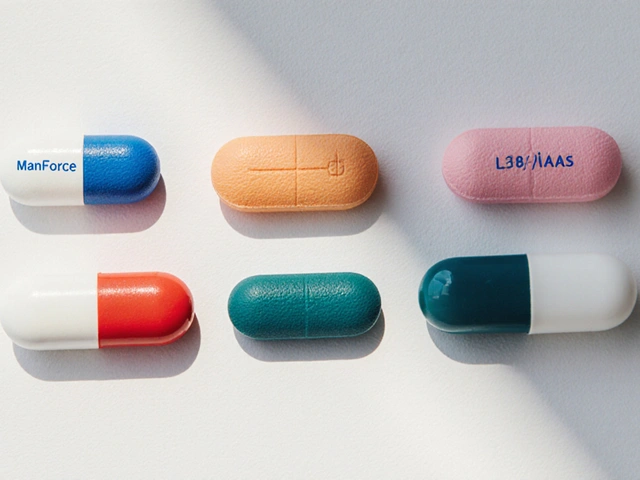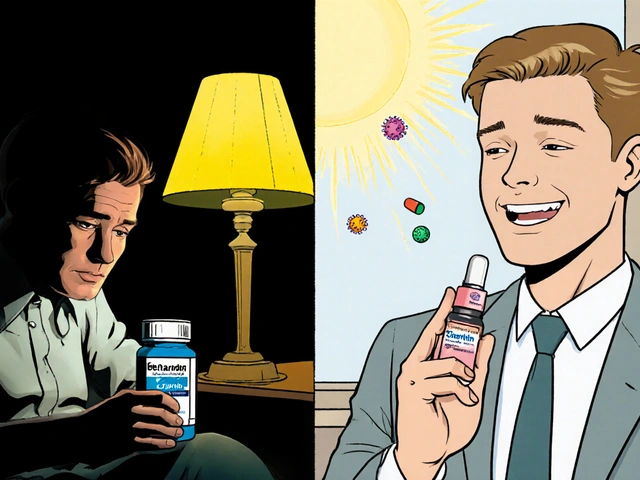Medication Guide Knowledge Check
How well do you know Medication Guides?
Test your knowledge about FDA-required patient safety information with this 5-question quiz. All answers are based on the article content.
1. What is the primary purpose of FDA-required Medication Guides?
2. What reading level must Medication Guides be written at?
3. Which of these is a requirement for Medication Guides?
4. What percentage reduction in preventable adverse events did studies show for drugs with Medication Guides?
5. What should you do if you don't understand a risk warning in a Medication Guide?
Key Takeaways
- Medication Guides are FDA‑mandated, plain‑language documents for high‑risk prescription drugs.
- They must be handed to patients at the pharmacy and cover risks, safe use, storage, and disposal.
- Guides differ from package inserts and counseling sheets by being reviewed by the FDA and written at a ≤6th‑grade reading level.
- Evidence shows they cut preventable adverse events by roughly 20% for covered drugs.
- Digital and visual enhancements are emerging to boost comprehension.
When you pick up a prescription for a medication that carries serious safety warnings, you’ll often see a folded sheet titled “Medication Guide.” Those sheets are not optional handouts; they are a legal requirement from the Food and Drug Administration (FDA) that aims to protect you from preventable harm.
What a Medication Guide Is
A Medication Guide is a patient‑focused label that the FDA includes in the official prescribing information of certain drugs. The agency defines it as "patient labeling that is part of the FDA‑approved prescription drug labeling for certain prescription drugs when the FDA determines that patient labeling could help prevent serious adverse reactions" (FDA, 2023). In plain English, if a drug’s risk profile is such that patients need extra help understanding how to use it safely, the FDA demands a Medication Guide.
These guides are developed by the drug manufacturer, reviewed by the FDA, and must be provided by the pharmacist at the moment the medication is dispensed. The legal backbone lives in 21 CFR Part 208, which obliges manufacturers to have the guides ready for distribution.
Why the FDA Requires Them
The FDA’s risk‑communication strategy rests on three pillars: clear labeling, professional counseling, and patient education. Medication Guides lock in the education piece by delivering consistent, evidence‑based information in language most adults can read. Studies cited by the agency show a 22% drop in preventable adverse events for drugs with required guides compared with similar drugs lacking them (FDA CBER, 2023).
Guides become especially crucial for drugs that are part of a Risk Evaluation and Mitigation Strategy (REMS). REMS programs add layers-like restricted distribution or regular monitoring-to keep high‑risk drugs safe, and a Medication Guide is the core patient‑focused component of those layers.
Core Elements Every Medication Guide Must Contain
- Drug identity: brand and generic names.
- Approved uses: what the drug is meant to treat.
- Serious risks and side effects: highlighted in bold.
- Safe‑use instructions: dosing, what to avoid, timing.
- Storage and disposal: how to keep the medicine stable and how to get rid of leftovers safely.
- When to seek help: red‑flag symptoms that require immediate medical attention.
All sections are presented with large headings, bullet points, and simple sentences to meet the FDA’s ≤sixth‑grade reading requirement.
Medication Guides vs. Other Patient Information Sources
It helps to see the guide side‑by‑side with the other documents patients often receive.
| Aspect | Medication Guide | Package Insert (Prescribing Information) | Pharmacy Counseling Sheet |
|---|---|---|---|
| Regulatory authority | FDA‑mandated, reviewed, and approved | FDA‑mandated for clinicians only | Pharmacy‑generated, no federal requirement |
| Target audience | Patients, written in plain language | Healthcare professionals, technical jargon | Patients, varies widely in style |
| Reading level | ≤ 6th‑grade | Professional (≥ 12th‑grade) | Unstandardized |
| Distribution requirement | Must be given with every prescription (new & refill) | Included in drug packaging, not handed out | Provided at pharmacist’s discretion |
| Effect on comprehension (studies) | 37% higher vs. counseling sheets (JAPhA 2022) | Not measured for patients | Variable, often lower |
Real‑World Impact: What the Numbers Tell Us
As of October 2023, about 150 prescription products-roughly 5% of the U.S. market-carry mandatory Medication Guides. The majority are biologics, opioids, and psychiatric drugs. The FDA’s 2023 Drug Safety Annual Report linked these guides to a 22% reduction in preventable adverse events for the covered medications.
A meta‑analysis in The Lancet (2023) pooled data from eight trials and found a 19.3% drop in serious adverse events when a guide was required (95% CI 14.7‑23.5%). In plain terms, for every 100 patients on a high‑risk drug, roughly 19 serious problems are avoided thanks to the guide.
Challenges in the Pharmacy Workflow
Pharmacists are the last line of defense, but they face time pressure. A 2022 University of Michigan study showed pharmacists spend an average of 47 seconds explaining a Medication Guide, yet comprehension jumps to 52% when the discussion lasts 2‑3 minutes. The American Society of Health‑System Pharmacists (ASHP) reports that 41% of pharmacies experienced guide shortages in 2022, often for oncology drugs.
Practical tips that the FDA’s Division of Medication Error Prevention recommends:
- Highlight the three most critical safety points during counseling.
- Use teach‑back: ask the patient to repeat the key warning in their own words.
- Store guides in color‑coded bins for quick access.
Digital Evolution: Electronic and Interactive Guides
Static paper has limits-no personalization, no video, no quick search. The FDA’s 2020 Digital Health Innovation Action Plan opened the door for electronic delivery. In 2023, the agency approved the first “Interactive Medication Guide” for Jardiance. That guide includes a QR code that pulls up a short animation, a risk‑stratified checklist, and a printable reminder card.
Early pilots show 18% of patients opting for an electronic version when asked, and satisfaction scores climb when visual icons replace dense paragraphs. The FDA’s 2022 final rule (87 FR 64583) now permits electronic delivery on patient request, paving the way for mobile‑app integration.
Future Directions: Human‑Centered Design and Multilingual Access
The 2023‑2025 Strategic Plan for Patient Communication earmarks three upgrades by 2025:
- Standardized visual risk icons (Q3 2024).
- Multilingual guides for the top 25 non‑English languages (Q1 2025).
- Integration with electronic health records to trigger automatic pharmacist alerts (ongoing).
Industry groups are already prototyping “tear‑off reminder cards” that patients can keep in a pill organizer. The Institute for Safe Medication Practices (ISMP) urges broader adoption of such human‑factors designs.
How Patients Can Make the Most of Medication Guides
Even the best guide won’t help if it’s tossed aside. Here’s a quick checklist you can follow:
- When you receive a prescription, ask the pharmacist: “Do I have a Medication Guide for this drug?”
- Read the three bolded risk statements first.
- Mark the “when to call your doctor” symptoms with a highlighter.
- If the guide feels dense, ask the pharmacist to walk you through the key points.
- Consider scanning any QR code for an animated version; many providers link to videos in Spanish, Mandarin, and Arabic.
Following these steps can boost your understanding and protect you from avoidable side effects.
Frequently Asked Questions
What types of drugs require a Medication Guide?
The FDA mandates guides for about 150 prescription products, mainly high‑risk categories such as opioids, biologics, certain psychiatric drugs, and medications that are part of a REMS program.
How is a Medication Guide different from the pharmacy’s counseling sheet?
Counseling sheets are optional, pharmacy‑specific handouts with variable quality. Medication Guides are FDA‑approved, must be given with every prescription, and are written at a ≤6th‑grade reading level.
Can I get an electronic Medication Guide?
Yes. Since the FDA’s 2022 final rule, pharmacies may provide an electronic version if the patient requests it. Many chains now offer QR‑code links to digital guides.
What should I do if I don’t understand a risk warning?
Call your pharmacist right away. They are required to explain the guide and can use teach‑back methods to confirm you grasp the information.
Do Medication Guides reduce medication errors?
Research shows a 19‑20% reduction in serious adverse events for drugs with required guides, indicating a measurable drop in error‑related harms.
Bottom line: a Medication Guide is a legally required safety net that translates complex drug risks into language you can act on. Knowing what it is, why it exists, and how to use it can keep you safer and more confident in your treatment.







October 24, 2025 AT 22:31
Great summary! 🎉 The Medication Guide really is a lifesaver when it’s written in plain language. 🌟 It’s awesome that the FDA pushes for ≤6th‑grade reading level – that makes a huge difference for folks with varying literacy. 🙌 Remember to highlight those bolded risk statements the first time you read the guide. 🤗